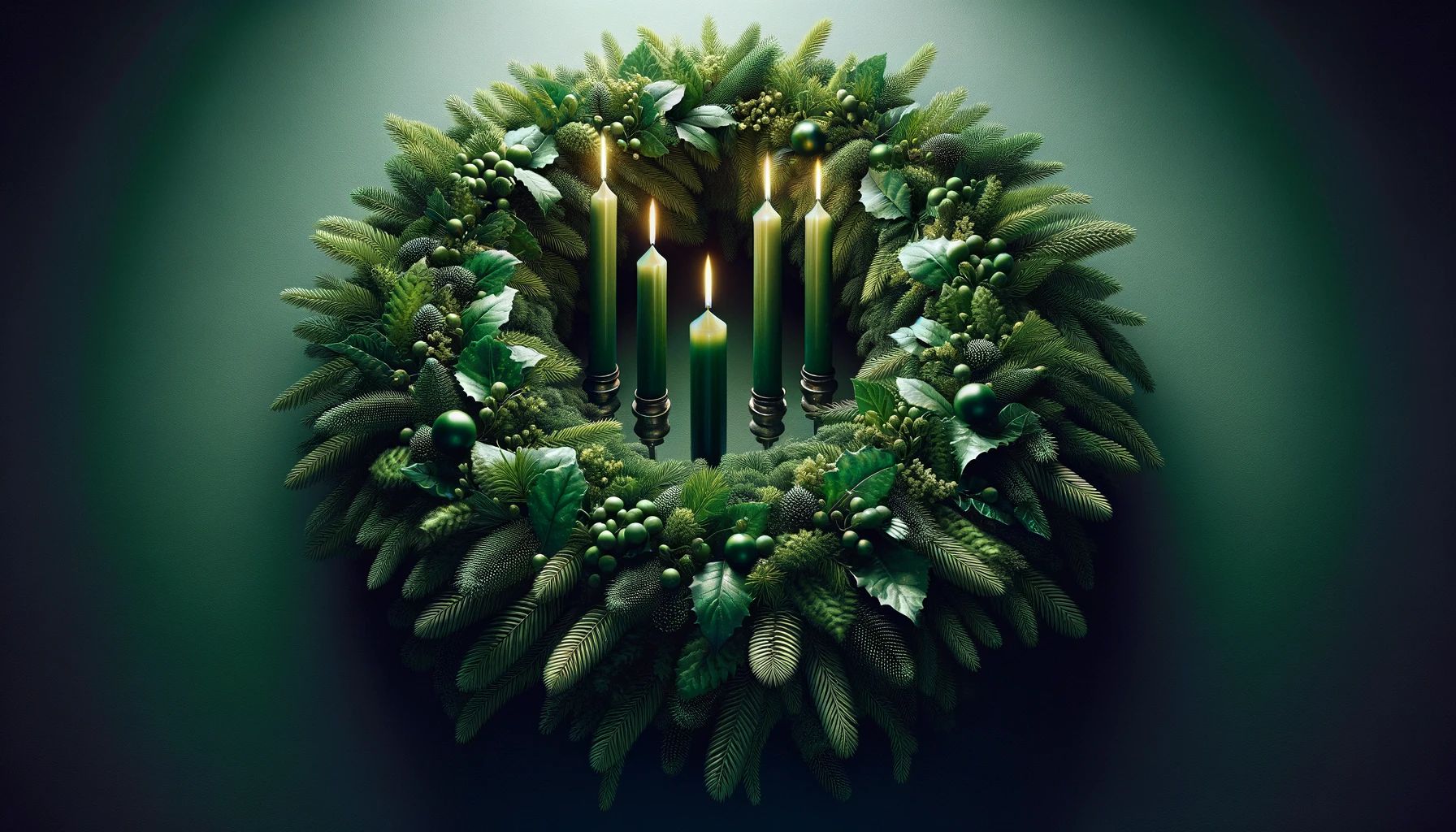Home>Special Themes>Why Is The Third Candle Pink On Advent Wreath


Special Themes
Why Is The Third Candle Pink On Advent Wreath
Published: February 14, 2024
Jason DeRose, Managing Editor at Christian.net, uses his expertise in religion and journalism to deepen understanding of faith's societal impacts. His editorial leadership, coupled with a strong academic background, enriches the platform’s diverse content, earning him recognition in both journalism and religious circles.
Discover the significance of the pink candle on the Advent wreath and its connection to special themes during the Advent season. Explore the tradition and meaning behind this unique symbol.
(Many of the links in this article redirect to a specific reviewed product. Your purchase of these products through affiliate links helps to generate commission for Christian.net, at no extra cost. Learn more)
Table of Contents
Introduction
The Advent season is a time of anticipation and preparation for the celebration of the birth of Jesus Christ. One of the most recognizable symbols of this season is the Advent wreath, a cherished tradition in many Christian households and congregations. This wreath typically consists of evergreen branches, symbolizing eternal life, and is adorned with four candles, often nestled in a circle of greenery.
As the weeks of Advent progress, a candle is lit each Sunday, with the final candle being lit on Christmas Eve or Christmas Day. The lighting of these candles represents the increasing brightness and hope brought by the imminent arrival of the Christ child.
The Advent wreath serves as a powerful visual reminder of the spiritual significance of the season, guiding individuals and families through a period of reflection, prayer, and joyful anticipation. Each candle holds its own unique symbolism, and the third candle, often distinguished by its pink hue, holds a special significance within the Advent tradition.
In the following sections, we will delve into the rich symbolism and historical significance of the pink candle on the Advent wreath, exploring its connection to joy and rejoicing, and shedding light on its modern interpretations. Join us on this enlightening journey through the heartwarming traditions of the Advent season.
Read more: Why Is The Advent Candle Pink
The Meaning of the Advent Wreath
The Advent wreath holds profound symbolism, encapsulating the essence of the Advent season and serving as a visual representation of the spiritual journey towards the celebration of Christ's birth. Comprised of evergreen branches, the circular shape of the wreath signifies eternity and the unending nature of God's love. The evergreen foliage, which remains vibrant and verdant even in the depths of winter, represents the enduring hope and life found in Christ.
The wreath typically features four candles, each representing a week of the Advent season. The first two candles are traditionally purple, symbolizing penitence, preparation, and the royalty of Christ. The third candle, often pink or rose-colored, embodies joy and rejoicing, marking a significant shift in the tone of the Advent observance. Finally, the fourth candle, also purple, represents love and serves as a prelude to the arrival of the Christ child.
As the weeks progress, the lighting of the candles illuminates the increasing anticipation and hope associated with the imminent arrival of Christmas. The gradual illumination of the wreath mirrors the spiritual journey towards the birth of Jesus, with each candle casting its warm glow as a beacon of faith and expectation.
The Advent wreath, with its timeless symbolism and ritualistic lighting of candles, fosters a sense of unity and shared devotion within families and congregations. It provides a focal point for prayer, reflection, and the retelling of the biblical narrative, reinforcing the spiritual significance of the season.
In essence, the Advent wreath serves as a poignant reminder of the enduring hope, joy, love, and anticipation that characterize the Advent season, inviting individuals to embark on a meaningful journey of spiritual preparation and celebration as they await the arrival of the Christ child.
The Symbolism of the Pink Candle
Amidst the solemnity of the Advent season, the introduction of the pink candle on the Advent wreath infuses a distinct sense of joy and anticipation. This unique candle, often referred to as the "Shepherd's Candle," stands out with its rosy hue, symbolizing a shift in the tone of the Advent observance. The pink candle is traditionally lit on the third Sunday of Advent, known as Gaudete Sunday, deriving its name from the Latin word "gaudete," meaning "rejoice."
The pink candle embodies the theme of rejoicing and represents a moment of respite and celebration within the Advent journey. Its placement in the midst of the purple candles, which symbolize penitence and preparation, serves as a vibrant reminder of the imminent arrival of the Christ child and the joyous fulfillment of God's promises. As the pink candle is illuminated, it radiates a message of hope, exuberance, and the anticipation of the fulfillment of God's redemptive plan.
The color pink, often associated with warmth, tenderness, and compassion, further enriches the symbolism of the pink candle. It serves as a visual testament to the tender love and compassion embodied in the incarnation of Jesus Christ, inviting individuals to embrace the profound joy that accompanies the anticipation of His birth. The pink candle's gentle glow serves as a beacon of hope, dispelling the shadows of doubt and heralding the arrival of the long-awaited Messiah.
In essence, the pink candle on the Advent wreath encapsulates the essence of Gaudete Sunday, inviting individuals to pause and rejoice amidst the spiritual preparations of the season. Its symbolism serves as a poignant reminder that while the Advent journey involves introspection and preparation, it is also a time to embrace the profound joy and hope brought by the promise of salvation. The pink candle stands as a luminous symbol of the joyful anticipation that permeates the hearts of believers as they eagerly await the celebration of the birth of Jesus Christ.
As the pink candle is kindled, its radiant glow serves as a visual proclamation of the joyous fulfillment of God's promises and the imminent arrival of the Savior. It beckons individuals to embrace the spirit of rejoicing, infusing the Advent season with a sense of warmth, optimism, and profound anticipation.
Historical Significance of the Third Candle
The historical significance of the third candle on the Advent wreath can be traced back to centuries-old Christian traditions and observances. As the Advent season evolved over time, the symbolism and rituals associated with the lighting of the candles, including the introduction of the pink candle, became deeply ingrained in the fabric of Christian worship and observance.
The use of the Advent wreath itself can be traced back to 16th-century Germany, where it served as a visual and symbolic representation of the anticipation and preparation for the celebration of Christ's birth. The gradual illumination of the candles over the four weeks of Advent mirrored the increasing brightness and hope brought by the imminent arrival of the Christ child.
The specific historical origins of the pink candle can be linked to the liturgical calendar and the observance of Gaudete Sunday, which falls on the third Sunday of Advent. Gaudete Sunday, with its emphasis on rejoicing, marked a pivotal moment within the Advent season, signifying a shift from solemn anticipation to joyful expectation.
The introduction of the pink candle on Gaudete Sunday served as a poignant reminder to believers that amidst the penitential preparations, there existed a profound and abiding sense of joy and hope. This historical significance is deeply rooted in the theological and liturgical traditions of the Church, reflecting the delicate balance between introspection and exuberant anticipation that characterizes the Advent season.
As the centuries passed, the historical significance of the third candle continued to resonate within Christian communities, serving as a tangible symbol of the enduring joy and hope found in the promise of Christ's coming. The pink candle, with its historical ties to Gaudete Sunday and the broader Advent narrative, remains a cherished emblem of the profound spiritual journey undertaken by believers as they prepare to celebrate the birth of Jesus Christ.
In essence, the historical significance of the third candle on the Advent wreath is a testament to the enduring traditions and timeless symbolism that have enriched the Advent season for generations. Its presence serves as a poignant reminder of the historical roots of the Advent observance and the profound theological truths that underpin the joyful anticipation of Christ's birth.
The Connection to Joy and Rejoicing
The connection between the pink candle on the Advent wreath and the themes of joy and rejoicing is deeply rooted in the spiritual essence of the Advent season. As the third candle is kindled on Gaudete Sunday, it heralds a pivotal shift in the tone of the Advent observance, inviting individuals to embrace a profound sense of joy amidst their preparations for the celebration of Christ's birth.
The Advent season, with its emphasis on anticipation, reflection, and spiritual preparation, often carries a solemn and introspective tone. However, the introduction of the pink candle serves as a luminous beacon, illuminating the path to rejoicing and exuberant hope. This connection to joy is a testament to the transformative power of the Advent journey, guiding individuals from a posture of penitence to one of jubilation as they await the arrival of the Christ child.
The pink candle, with its radiant hue, symbolizes the imminent fulfillment of God's promises and the joyous anticipation of the Savior's birth. Its placement amidst the purple candles, which represent penitence and preparation, serves as a poignant reminder that the Advent season is not solely a time of solemn reflection, but also a season of profound rejoicing. The pink candle infuses the Advent observance with a sense of warmth, optimism, and eager anticipation, inviting individuals to embrace the joy that accompanies the promise of salvation.
The connection to joy and rejoicing embodied in the pink candle extends beyond the confines of the Advent wreath, permeating the hearts and minds of believers as they journey through the season. It serves as a tangible reminder that the anticipation of Christ's birth is not merely a passive waiting, but a joyous and transformative experience that ignites the spirit with hope and exuberance.
In essence, the connection to joy and rejoicing represented by the pink candle on the Advent wreath encapsulates the profound emotional and spiritual dimensions of the Advent season. It beckons individuals to embrace the joy that emanates from the promise of redemption and the imminent arrival of the Savior, infusing the season with a sense of radiant hope and profound celebration.
Read more: Why Pink And Purple Candles At Advent
Modern Interpretations of the Pink Candle
In contemporary times, the symbolism of the pink candle on the Advent wreath continues to resonate deeply within Christian communities, offering a timeless message of hope, joy, and anticipation. Modern interpretations of the pink candle embrace its significance as a beacon of light amidst the darkness, symbolizing the imminent arrival of the Christ child and the transformative power of His birth.
One modern interpretation of the pink candle centers on the theme of resilience and perseverance. In a world often fraught with challenges and uncertainties, the pink candle serves as a poignant reminder that amidst adversity, there exists a profound source of joy and hope. Its gentle glow illuminates the path forward, inspiring individuals to embrace resilience and unwavering faith as they await the celebration of Christ's birth.
Furthermore, the pink candle holds significance as a symbol of inclusivity and compassion within contemporary interpretations of the Advent season. Its warm, inviting hue serves as a reminder of the boundless love and compassion embodied in the message of Christ's birth. In a world marked by division and discord, the pink candle stands as a luminous symbol of unity, inviting individuals to extend compassion and kindness to all, mirroring the inclusive love exemplified in the life and teachings of Jesus Christ.
Moreover, the modern interpretation of the pink candle encompasses a celebration of diversity and individuality within the Advent journey. Its distinct color and symbolism serve as a vibrant testament to the multifaceted tapestry of humanity, inviting individuals from all walks of life to embrace the joy and hope found in the promise of Christ's coming. The pink candle encourages a celebration of the unique gifts and experiences that each individual brings to the Advent season, fostering a spirit of inclusivity and acceptance.
In essence, modern interpretations of the pink candle on the Advent wreath reflect the enduring relevance and profound symbolism of this cherished tradition. Its message of resilience, inclusivity, and celebration resonates deeply with individuals as they navigate the complexities of the modern world, infusing the Advent season with a sense of profound hope, joy, and unity.
Conclusion
In conclusion, the pink candle on the Advent wreath stands as a luminous symbol of joy, hope, and anticipation within the rich tapestry of the Advent season. Its historical significance, rooted in centuries-old Christian traditions, continues to resonate deeply within contemporary interpretations of the season, offering a timeless message of resilience, inclusivity, and celebration.
As the pink candle is kindled on Gaudete Sunday, it serves as a radiant reminder that amidst the solemn preparations for Christ's birth, there exists a profound and abiding sense of joy. Its gentle glow illuminates the hearts and minds of believers, inviting them to embrace the transformative power of the Advent journey and the imminent fulfillment of God's promises.
The symbolism of the pink candle extends beyond the confines of the Advent wreath, permeating the spiritual landscape with warmth, optimism, and a sense of unity. It beckons individuals to embrace the joy that emanates from the promise of redemption and the imminent arrival of the Savior, infusing the season with a profound sense of celebration and hope.
In the modern context, the pink candle embodies a message of resilience, inclusivity, and compassion, serving as a beacon of light amidst the complexities of the contemporary world. Its warm, inviting hue invites individuals to embrace unwavering faith, extend compassion to all, and celebrate the diverse tapestry of humanity, mirroring the inclusive love exemplified in the life and teachings of Jesus Christ.
As we journey through the Advent season, the pink candle stands as a timeless symbol of the enduring hope and joy found in the promise of Christ's birth. It invites us to pause, rejoice, and embrace the transformative power of the season, infusing our hearts with radiant hope and profound celebration as we eagerly anticipate the arrival of the Christ child.
In essence, the pink candle on the Advent wreath serves as a poignant reminder that amidst the solemn preparations, there exists a profound and abiding sense of joy. Its gentle glow illuminates the hearts and minds of believers, inviting them to embrace the transformative power of the Advent journey and the imminent fulfillment of God's promises.














